Postnatal refinement of auditory hair cell planar polarity deficits occurs in the absence of Vangl2
- PMID: 23986237
- PMCID: PMC3756750
- DOI: 10.1523/JNEUROSCI.1307-13.2013
Postnatal refinement of auditory hair cell planar polarity deficits occurs in the absence of Vangl2
Abstract
The distinctive planar polarity of auditory hair cells is evident in the polarized organization of the stereociliary bundle. Mutations in the core planar cell polarity gene Van Gogh-like 2 (Vangl2) result in hair cells that fail to properly orient their stereociliary bundles along the mediolateral axis of the cochlea. The severity of this phenotype is graded along the length of the cochlea, similar to the hair cell differentiation gradient, suggesting that an active refinement process corrects planar polarity phenotypes in Vangl2 knock-out (KO) mice. Because Vangl2 gene deletions are lethal, Vangl2 conditional knock-outs (CKOs) were generated to test this hypothesis. When crossed with Pax2-Cre, Vangl2 is deleted from the inner ear, yielding planar polarity phenotypes similar to Vangl2 KOs at late embryonic stages except that Vangl2 CKO mice are viable and do not have craniorachischisis like Vangl2 KOs. Quantification of planar polarity deficits through postnatal development demonstrates the activity of a Vangl2-independent refinement process that rescues the planar polarity phenotype within 10 d of birth. In contrast, the Pax2-Cre;Vangl2 CKO has profound changes in the shape and distribution of outer pillar cell and Deiters' cell phalangeal processes that are not corrected during the period of planar polarity refinement. Auditory brainstem response analyses of adult mice show a 10-15 dB shift in auditory threshold, and distortion product otoacoustic emission measurements indicate that this mild hearing deficit is of cochlear origin. Together, these data demonstrate a Vangl2-independent refinement mechanism that actively reorients auditory stereociliary bundles and reveals an unexpected role of Vangl2 during supporting cell morphogenesis.
Figures
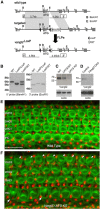
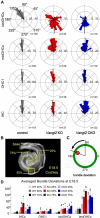


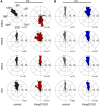


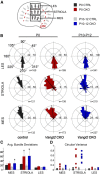
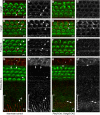
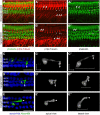

Similar articles
-
Non-cell-autonomous planar cell polarity propagation in the auditory sensory epithelium of vertebrates.Dev Biol. 2011 Apr 1;352(1):27-39. doi: 10.1016/j.ydbio.2011.01.009. Epub 2011 Jan 19. Dev Biol. 2011. PMID: 21255565 Free PMC article.
-
Adaptor protein-3 complex is required for Vangl2 trafficking and planar cell polarity of the inner ear.Mol Biol Cell. 2019 Aug 15;30(18):2422-2434. doi: 10.1091/mbc.E16-08-0592. Epub 2019 Jul 3. Mol Biol Cell. 2019. PMID: 31268833 Free PMC article.
-
Identification of Vangl2 and Scrb1 as planar polarity genes in mammals.Nature. 2003 May 8;423(6936):173-7. doi: 10.1038/nature01618. Epub 2003 Apr 30. Nature. 2003. PMID: 12724779
-
A balance of form and function: planar polarity and development of the vestibular maculae.Semin Cell Dev Biol. 2013 May;24(5):490-8. doi: 10.1016/j.semcdb.2013.03.001. Epub 2013 Mar 15. Semin Cell Dev Biol. 2013. PMID: 23507521 Free PMC article. Review.
-
Planar cell polarity in the inner ear.Curr Top Dev Biol. 2012;101:111-40. doi: 10.1016/B978-0-12-394592-1.00006-5. Curr Top Dev Biol. 2012. PMID: 23140627 Review.
Cited by
-
PCP Auto Count: A Novel Fiji/ImageJ plug-in for automated quantification of planar cell polarity and cell counting.bioRxiv [Preprint]. 2024 Feb 15:2024.01.30.578047. doi: 10.1101/2024.01.30.578047. bioRxiv. 2024. Update in: Front Cell Dev Biol. 2024 May 17;12:1394031. doi: 10.3389/fcell.2024.1394031. PMID: 38352473 Free PMC article. Updated. Preprint.
-
Frizzled3 and Frizzled6 Cooperate with Vangl2 to Direct Cochlear Innervation by Type II Spiral Ganglion Neurons.J Neurosci. 2019 Oct 9;39(41):8013-8023. doi: 10.1523/JNEUROSCI.1740-19.2019. Epub 2019 Aug 28. J Neurosci. 2019. PMID: 31462532 Free PMC article.
-
Epithelial geometry regulates spindle orientation and progenitor fate during formation of the mammalian epidermis.Elife. 2019 Jun 12;8:e47102. doi: 10.7554/eLife.47102. Elife. 2019. PMID: 31187731 Free PMC article.
-
Actin Crosslinking Family Protein 7 Deficiency Does Not Impair Hearing in Young Mice.Front Cell Dev Biol. 2021 Nov 30;9:709442. doi: 10.3389/fcell.2021.709442. eCollection 2021. Front Cell Dev Biol. 2021. PMID: 34917607 Free PMC article.
-
Topologically correct central projections of tetrapod inner ear afferents require Fzd3.Sci Rep. 2019 Jul 16;9(1):10298. doi: 10.1038/s41598-019-46553-6. Sci Rep. 2019. PMID: 31311957 Free PMC article.
References
-
- Andre P, Wang Q, Wang N, Gao B, Schilit A, Halford MM, Stacker SA, Zhang X, Yang Y. The Wnt coreceptor Ryk regulates Wnt/planar cell polarity by modulating the degradation of the core planar cell polarity component Vangl2. J Biol Chem. 2012;287:44518–44525. doi: 10.1074/jbc.M112.414441. - DOI - PMC - PubMed
-
- Collado MS, Thiede BR, Baker W, Askew C, Igbani LM, Corwin JT. The postnatal accumulation of junctional E-cadherin is inversely correlated with the capacity for supporting cells to convert directly into sensory hair cells in mammalian balance organs. J Neurosci. 2011;31:11855–11866. doi: 10.1523/JNEUROSCI.2525-11.2011. - DOI - PMC - PubMed
Publication types
MeSH terms
Substances
Grants and funding
LinkOut - more resources
Full Text Sources
Other Literature Sources
Molecular Biology Databases
Research Materials
Miscellaneous
